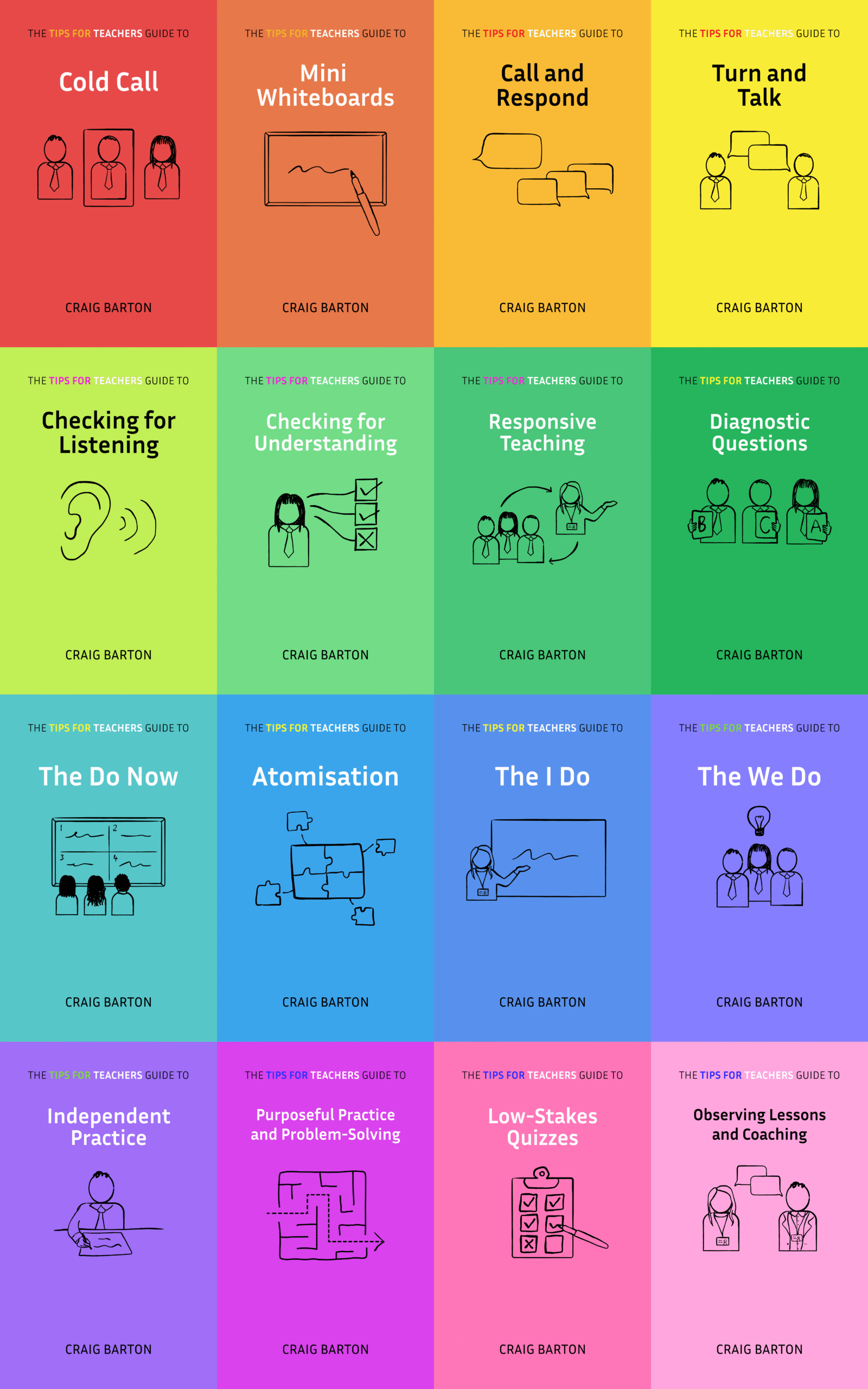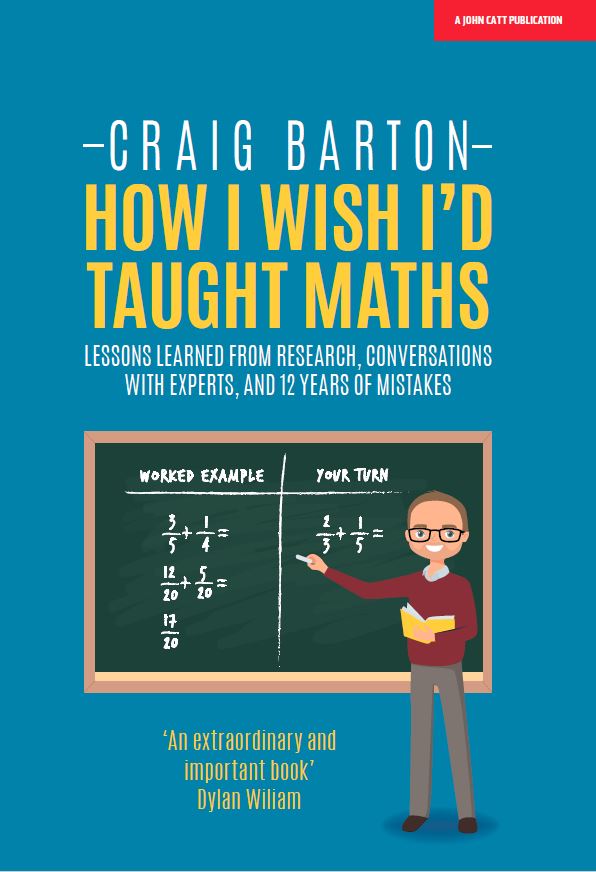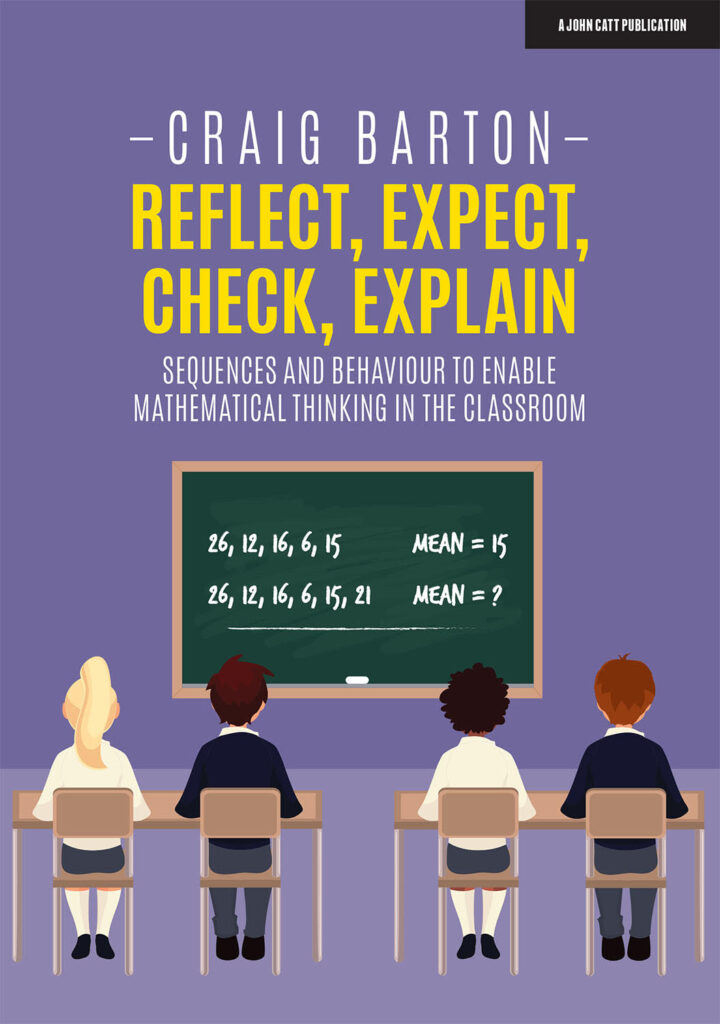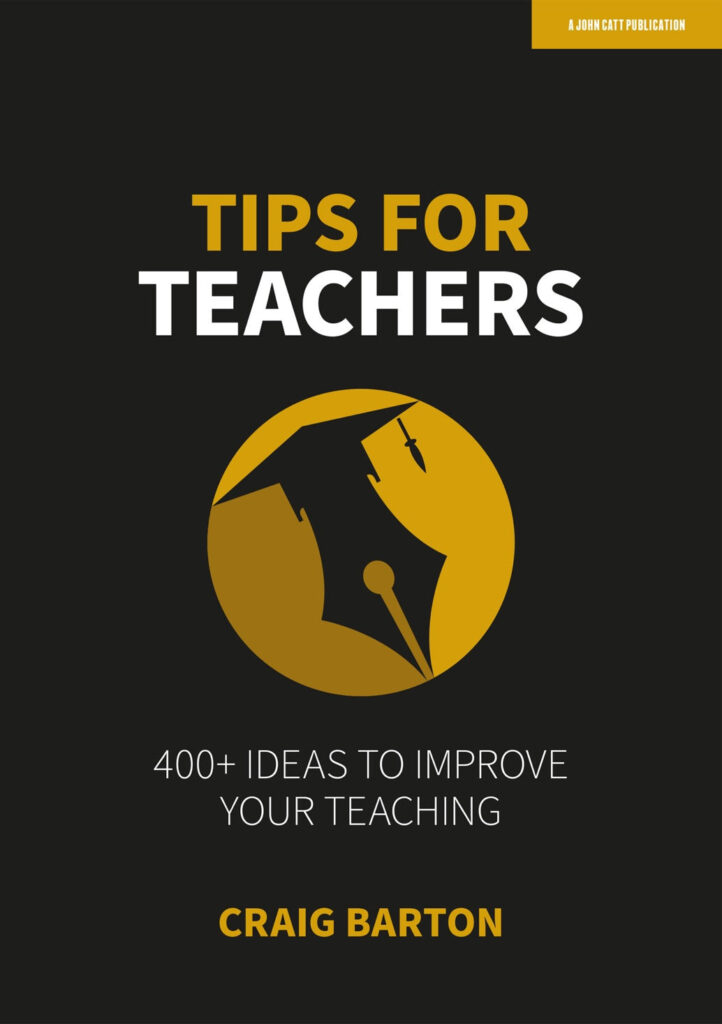
Each book in the Tips for Teachers guide to… series is crammed full of evidence-based, practical strategies you can try the very next time you step into a classroom, based on the 1000s of lessons I’ve had the privilege to observe in the last few years.
There are 16 books in the series. The plan is to release one book every Wednesday… assuming this project doesn’t finish me off!
Each book is designed to be a workbook rather than a passive document. I want you to scribble all over them. After considering each idea in a book, you’ll have the opportunity to place it on a set of axes to help prioritise, jot down notes about how you plan to implement it, and later reflect on what happened when you tried the idea out.

The books can be worked through by an individual teacher wishing to improve their practice, by a department or school with a particular CPD focus, or used to support coaching by utilising the books’ concrete strategies.
Each book is priced at £8, available in paperback or on Kindle (I recommend the paperback so you can write on them), and are for sale in Amazon stores worldwide. I can offer discounts for UK orders of 30+ books – just email me at mrbartonmaths (at) gmail.com.
I am really proud of these books. I hope you and your colleagues find them useful.
Book 1: Cold Call
Cold Call is when the teacher chooses which student to answer a question as opposed to asking for a volunteer. It sounds so simple. However, there are several pitfalls we can encounter when using Cold Call that reduce its effectiveness, as well as several techniques we can employ to encourage students to think more deeply during our lessons.
In the Tips for Teachers guide to Cold Call, Craig Barton shares 21 strategies to maximise the effectiveness of Cold Call, each of which can be implemented the very next time you step into a classroom.
Available to buy in paperback or on Kindle. View the supporting resources page here.
Book 2: Mini-whiteboards
Mini-whiteboards have a unique advantage over any other means of student participation: they allow us to see the answers of all students to any question immediately. However, mini-whiteboards can be a faff and a distraction if we don’t nail our routines.
In the Tips for Teachers guide to mini-whiteboards, Craig Barton shares a series of strategies to reduce the costs of using mini-whiteboards and ramp up their benefits. Each of these ideas can be implemented the very next time you step into a classroom.
Available to buy in paperback or on Kindle. View the supporting resources page here.

Book 3: Call and Respond
Call and Respond is a technique where the teacher says the first part of a statement, and the students complete the second half out loud, and in unison. It may seem unnecessary or a bit weird, but it is a vital part of many high-performing teachers’ toolkits. It can help students automate everything from definitions to classroom expectations, fostering an energetic and inclusive classroom environment.
In the Tips for Teachers guide to Call and Respond, Craig Barton dives into the strategies needed to drive up the effectiveness of Call and Respond, each of which can be implemented the very next time you step into a classroom.
Available to buy in paperback or on Kindle. View the supporting resources page here.

Book 4: Turn and Talk
Turn and Talk refers to a structured discussion between two students. If we get Turn and Talk right, our students learn from each other. If we get Turn and Talk wrong, certain students dominate, other students drift off task, and we face a battle trying to regain focus.
In the Tips for Teachers guide to Turn and Talk, Craig Barton shares concrete strategies to help all students make the most of these peer-to-peer conversations. Each strategy can be implemented the very next time you step into a classroom.
Available to buy in paperback or on Kindle. View the supporting resources page here.

Book 5: Checking for Listening
Most of our students are not listening as much as we hope they are. This is clearly a problem – if students are not listening, then they are less likely to understand our explanations, more likely to ignore our instructions, and will miss opportunities to learn from their peers.
In the Tips for Teachers guide to Checking for Listening, Craig Barton shares concrete strategies first to ensure that our students can listen to our explanations, instructions, and contributions from their peers, and second to provide an incentive to listen. Each strategy can be implemented the very next time you step into a classroom.
Available to buy in paperback or on Kindle. View the supporting resources page here.

Book 6: Checking for Understanding
Teaching without checking for understanding is like painting with our eyes closed. Many teachers rely on poor proxies for understanding, such as the response of one student or a group of students telling us they understand. This inevitably causes issues when we later find out that our students’ understanding was not as secure as we believed.
In the Tips for Teachers guide to Checking for Understanding, Craig Barton shares 11 strategies that all teachers can follow to ensure their checks for understanding are as reliable and valid as possible. Each strategy can be implemented the very next time you step into a classroom.
Available to buy in paperback or on Kindle. View the supporting resources page here.

Book 7: Responsive Teaching
Gathering reliable data on our students’ levels of understanding is one challenge. However, an even greater challenge is knowing how to respond effectively to that data in the moment, amidst the noise of a busy classroom. What should we do if some students understand, but others don’t? What if no one gets it?
In the Tips for Teachers guide to Responsive Teaching, Craig Barton presents a model that all teachers can use to respond effectively to three of the most common situations they encounter. Each situation has its own set of strategies that can be implemented the very next time you step into a classroom.
Available to buy in paperback or on Kindle. View the supporting resources page here.

Book 8: Diagnostic Questions
Diagnostic multiple-choice questions have long been used to assess students’ understanding. However, not all diagnostic questions are created equally, and thinking does not need to stop once students have got the correct answer.
In the Tips for Teachers guide to Diagnostic questions, Craig Barton explores what makes a good diagnostic question and the best ways to gather student data live in the classroom. Then he considers innovative methods to use diagnostic questions beyond simply obtaining the correct answer, aiming to challenge students further and gain a more accurate sense of the depth of their understanding.
Available to buy in paperback or on Kindle. View the supporting resources page here.

Book 9: The Do Now
The Do Now is the activity students complete at the beginning of a lesson. A strong Do Now can help settle and focus students, reinforce their knowledge, and prepare you for a productive lesson. Sadly, the opposite is also true: many Do Nows leave the teacher spending the rest of the lesson trying to get learning back on track.
In the Tips for Teachers guide to The Do Now, Craig Barton explores those essential first few minutes of a lesson, analysing the content and structure of effective Do Nows, as well as the best ways to check for understanding and respond to students’ answers.
Available to buy in paperback or on Kindle. View the supporting resources page here.

Book 10: Atomisation
Atomisation involves breaking a concept into its smallest meaningful parts, called Atoms. Once you know the Atoms, there is a special way to teach them that ensures all students understand. Atomisation has the power to revolutionise how teachers plan and how students learn.
In The Tips for Teachers guide to Atomisation, Craig Barton leans on the work of Siegfried Englemann and Kris Boulton to develop a series of concrete strategies that any teacher can employ to Atomise effectively.
Warning: Whilst the breaking down of concepts in Atoms, and the teaching of both Categorical and Fact Atoms can be applied to any subject, Transformations and Routines are particularly well-suited to procedure-heavy subjects like maths. So, if you teach a different subject, especially one of the humanities, only 50% of this book may be relevant.
Available on 26th November.

Book 11: The I Do
The I Do is the phase of the lesson where the teacher explains and demonstrates a procedure to students. Many I Dos fail because the teacher inadvertently creates distractions, is unclear about what they are explaining, asks students to guess things they do not know, or gives a lecture that quickly loses students’ interest.
In The Tips for Teachers guide to The I Do, Craig Barton shares a series of practical strategies to help make the I Do as effective as possible. Each strategy can be applied the very next time you step into a classroom.
Warning: The principles of focusing thinking and explaining concepts that I describe in the first two sections of this book, and the options for supercharging the I Do that I describe in the final section, could be used to improve the explanation of any concept across any subject. But I only like to write about things I know well, so all the examples in this book come from the maths lessons I have observed and the maths teachers I have coached.
Available on 3rd December.

Book 12: The We Do
The We Do phase of a lesson serves two purposes. First, it is our opportunity to see whether our explanation makes sense. Second, it eases the transition between a teacher-led model and the independent practice that follows.
In The Tips for Teachers guide to the We Do, Craig Barton examines strategies to ensure the We Do is well chosen, every student participates, the check for understanding is reliable, and every student enters the subsequent independent practice confident and prepared.
Warning: Whilst the core idea of ensuring we have a reliable check for understanding of our explanation applies to any subject, procedure-heavy subjects like maths lend themselves particularly well to an I Do/We Do approach. More than any other in this series, this book is aimed squarely at maths teachers.
Available on 10th December.

Book 13: Independent practice
Often, students take a cognitive break the moment they are asked to do independent practice. This dip in effort can be hard to recover from, and the lesson quickly fizzles out.
In the Tips for Teachers guide to Independent Practice, Craig Barton examines strategies to prevent this from happening, focusing on task choice, giving instructions that students listen to, the crucial first 30 seconds, effective circulation, and maximising student participation when going through the answers.
Available on 17th December.

Book 14: Purposeful practice and Problem-solving
Whilst the consolidation of procedures is important, it is not everything. To support all our students – not just those in the top sets – to become confident, successful, and flexible mathematicians, we need to provide activities that challenge them to do more.
In The Tips for Teachers guide to Purposeful Practice and Problem-Solving, Craig Barton showcases six activity structures that can help our students think like mathematicians. Each structure comes with tips for coordinating them in the classroom, along with links to find the very best examples.
Warning: This book is only suitable for primary and secondary maths teachers. Teachers of other subjects, give this one a miss.
Available on 7th January.

Book 15: Low-Stakes Quizzes
A weekly Low-Stakes Quiz can be one of the most effective ways to provide students with a regular retrieval opportunity. Schools that have implemented Low-Stakes Quizzes have seen a significant improvement in retention and student motivation.
In The Tips for Teachers guide to Low-Stakes Quizzes, Craig Barton explores the features of an effective Low-Stakes Quiz, including its content, format, marking, and how students use their corrections in the future.
Available on 14th January.

Book 16: Observing Lessons and Coaching
Those who have the privilege to watch a colleague teach and then have a conversation with them about how to improve are duty-bound to do a good job.
In the Tips for Teachers guide to Observing Lessons and Coaching, Craig Barton describes his process for observing lessons – what data he collects and how he collects it. Craig then describes how this data informs the positive, productive coaching session that follows.
Available on 21st January.










